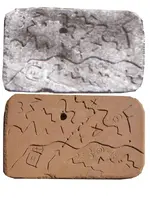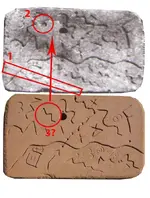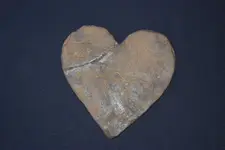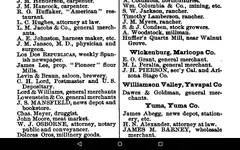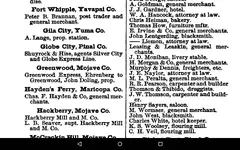More quotes from a historical book published late 1800's.
Below the quotes are screen shots showing a directory. M Peralta must have had a couple stores!
Another matter demanding brief mention here, as
pertaining to Arizona annals of the century, is the
Peralta grant of Gila lands. It is claimed that by
c^dula of December 20, 1748, the king, Fernando VI.,
in reward for services to the crown conferred on Don
Miguel Peralta de C6rdoba the title Baron de los
Colorados, and ordered the viceroy to grant him 300
leagues of land in the northern regions. On October
10, 1757, officials of the inquisition recommended the
grant, and certified on the testimony of Padre Paver
of Bac, of Padre Garcia, and of Bishop Tamaron, that
to the lands selected in Pimerfa Alta, the missions
had no conflicting claims. On Junuary 3, 1758, Vice-
roy Amarillas accordingly granted the tract north of
San Javier mission, including the Gila River, and ex-
tending ten leagues north and south by thirty leagues
east and west. In a document dated ' El Caudal de
Hidalgo, Pimerfa Alta/ May 13, 1758, Peralta, Ca-
ballero de los Colorados certifies that he has surveyed
the grant and formed the required map. The docu-
ments were recorded in the audiencia office at Gua-
dalajara, as shown by a certificate of June 23, 1768.
On August 1st of the same year, Peralta applied to
C&rlos III. for a confirmation granted by indorsement
December 2, 1772, and by a formal approval of Janu-
ary 22, 1776. By his will of 1788, Peralta bequeathed
the estate to his son Miguel Peralta, who in 1853, re-
siding at San Diego, California. , obtained from Presi-
dent Santa Anna a certified title, that is, copies of all
records in the case from the Mexican archives, with
the president's assurance of its validity and sufficiency.
From the younger . Peralta, the title passed in 1864 to
* l See chap. xii. of this volume.
PERALTA GRANT-MINES. 899
. George M. Willing, Jr, and from the latter in 1867
to James Addison Reavis, the present owner. 42 This
immense grant of over 2,000 square miles extends from
the region of the Pima villages eastward, for some
seventy-five miles up the Gila valley, including valu-
able portions of three counties. Respecting its va-
lidity, depending on the genuineness of the documents
and on various legal technicalities, I have of course no
opinion to express. In a sense the title is plausible
enough on its face; but it is somewhat remarkable
that the annals of the province, as recorded, contain no
allusion to Peralta, to the caballero de los Colorados,
or to the Caudal de Hidalgo.
Of mining operations in Arizona, during any portion
of the Spanish or Mexican period, nothing is practi-
cally or definitely known. The records are barely
sufficient to show that a few mines were worked, and
that the country was believed to be rich in silver and
gold. In several districts have been found traces of
these early workings; and these, with traditions aris-
ing from the Planchas de Plata find at Arizona proper
just south of the line, are for the most part
the only foundation for the many 'lost mines' of which much
has been vaguely written, and more said. I have al-
ready remarked that modern writers have greatly
exaggerated the country's former prosperity in mining
and other industries, and it may be added that they
have as a rule given the wrong date to such prosperity
"Reavis, 'El Caudal de Ifidalgo' (Peralta Grant), Before U. 8. Surveyor-
general of Arizona, etc Brief and argument of petitioner. S. F., 1884. Mr
Reavis has also shown me his MS. documents in the case, including photo-
graphic copies of the original papers, disefio, etc., from the Mez. archives,
furnished by authority of the governor of Jalisco and a Guadalajara court in
1881 and 1883; also photographs of doc. from the archives of S. Javier del Bac.
According to the original survey of 1758, the initial point or centre of the west-
ern boundary line was fixed in the current of the Gila, the line extending
thence south by the base of the Maricopa mountain on the east of the Sierra
Estrella, bearing to the west of the Sta Cruz valley, a distance of 5 leagues to
a point in the south boundary line; and from the same initial point north,
across the Gila and Salt rivers, 5 1. north to a point in the north boundary
line. I understand Mr B. to say that artificial corner marks have also been
found.






 Edit Post
Edit Post
